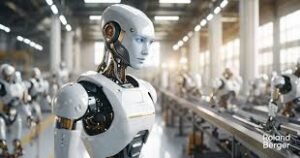“Humanoid Robots: A Glimpse into the Future”
Introduction:
Humanoid robot have come out from science fiction and into reality in the recent past. They have been designed to look like and act like humans and have become increasingly sophisticated and feasible at this juncture where an era in robotics is waiting to be dawned. It will now be necessary to go in-depth into the importance of humanoid robots in various walks of life, their technological advancement, and some ethics regarding their integration into human society.
What Are Humanoid Robots?
Humanoid robots are machines intended to be like a human in form and even behavior. They normally have heads, torsos, arms, and legs, making them able to do things in a manner that must be human-like as far as agility and movement are concerned. Such machines can be programmed to start conversations, recognize emotions, and even learn from interaction with humans.

Key Characteristics of Humanoid Robots:
Bipedal Locomotion: Many humanoid robots are built with the function of walking on two legs so that they can act like humans. This also allows them to walk into human environments.
Facial recognition: The advanced sensors on these robots make them look for human faces and recognize human expressions so that their interaction with humans can be a bit more natural.
Artificial Intelligence: AI algorithms let them learn from experience and adapt to new situations and enhance their responses over time.
Communication Skills: Humanoid robots can converse in natural language using NLP.
Applications of Humanoid Robots:
Humanoid robots are doing great work in most sectors.
Some of the prominent applications are:
1.Healthcare Industry:
The humanoid robots in the health care industry are used for the care and rehabilitation of the patients. Other sense applies in the aspect of fighting loneliness for the aged people or the disabled through helping in boosting their psychological state.
2. Education:
Humanoid robots are employed in the classrooms as teaching aids. They can interact with the students in interactive learning. What is taught might be mathematics or languages.
3. Customer Service:
Retailers and firms used humanoid robots as salespersons in customer care. Customers are welcomed, queries questions are answered, and they assist in making sales.
4. Recreation:
Humanoid robots are applied in theme parks and exhibitions as they entertain people in the entertainment industries. They can play in the movies or interact with the visitors entertainingly that one cannot tell what is technology from entertainment.

Technological Advances That Propel Humanoid Robots:
The following technological advances have driven the development of humanoid robots:
1. Robotics Engineering:
Robotics engineering has some of the most agile and stable designs of humanoid designs. The use of better material ensures light constructions that are nearer to humans.
2. Artificial Intelligence and Machine Learning:
This is what has drastically changed the way the humanoid robot learns from its surroundings.
4. Soft Robotics:
Soft robotics primarily entails the utilization of compliant materials that display motions that are close to those displayed by biological organisms.
Application of Humanoid Robots:
Humanoid robots have tremendous potential in transforming sectors and markets.
Some of the most significant applications include:
Healthcare industry: Assists in patients, physiotherapist, and geriatric care
Industrial manufacturing: Complex jobs are simpler to do with the human.
Teaching: It fosters the learner’s interactive approach and one on one mentorship
Problems and Ethical Issues:
Very promising and yet face huge challenges and ethics.
Expenses: Developing and maintaining the humanoid robot can be very expensive.
Safety: Human and robots’ safety in a shared environment
Job Displacement: Job becomes affected as the capabilities of the robots enhance.
Ethical Implications: Trying to answer questions on ethical use of AI and robotics
Ethics involved:
As humanoid robots continue to acquire more activities in daily life, ethical issues surface:
1. Job Loss:
A couple of such developments in industries would at least pose some dangers against unemployment also in various jobs.
2. Invasion of Privacy:
Serious privacy issues arise because of humanoid robots with cameras and sensors, and there is a need to put checks on data collection, storage, and usage in the interest of human rights.
3. Human-Robot Relationships:
Humanoid robot penetration into daily life raises questions about the nature of human-robot relationships.

Q1: What is the primary purpose of a humanoid robot?
A: Humanoid robots are used in medicine, learning, customer care, and entertainment among many other fields. They have been developed for various reasons in these fields. One of the reasons why they were developed is that they can help human beings to accomplish missions that require human-like interaction or physical skills.
Conclusion:
The humanoid robot have made a strong stride towards technological advancement. Such machines are continuously evolving, and their impacts can greatly improve our live

